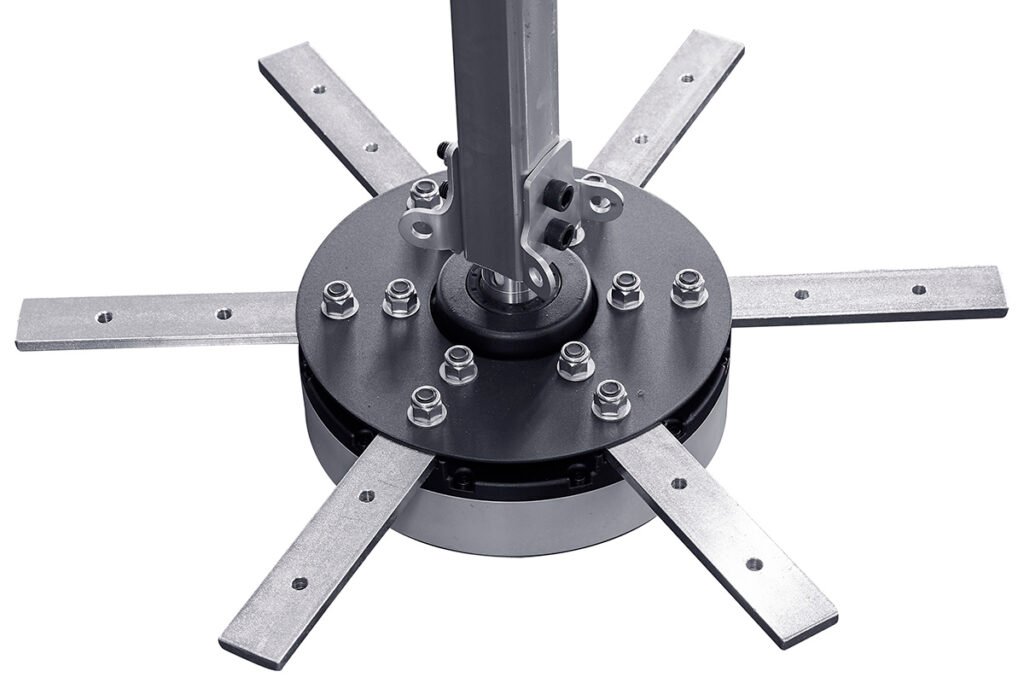
HVLS industrial fans equipped with PMSM (Permanent Magnet Synchronous Motor) offer a range of advantages, with high efficiency being a standout feature:
- Increased Energy Efficiency: PMSM motors are recognized for their high efficiency, which is typically higher than that of traditional induction motors. This means a greater proportion of the electrical energy is converted into mechanical energy, resulting in less energy loss and lower electricity bills. This is particularly beneficial for HVLS fans that operate over extended periods in large spaces, where cumulative energy savings can be significant.
- Optimized Power Consumption: The high efficiency of PMSM motors translates to better power consumption optimization. These motors can deliver the required performance while consuming less power, making them an eco-friendly choice for industrial applications aiming for sustainable operations.
- Reduced Operating Costs: The energy savings provided by PMSM motors directly contribute to reduced operating costs for HVLS fans. Over the long term, the lower energy consumption can lead to a positive return on investment, making these fans a cost-effective solution for industrial settings.
- Improved Performance: High efficiency in PMSM motors often correlates with improved overall performance. HVLS fans with these motors can provide powerful airflow and effective coverage across large areas, enhancing the working environment in industrial facilities.
- Consistent Operation: The high efficiency of PMSM motors ensures that HVLS fans operate consistently and reliably. This is crucial in industrial environments where the fans are expected to maintain a stable airflow, contributing to the comfort and productivity of the workers.
- Long-Term Savings: While the initial investment for PMSM motors might be higher, the long-term savings in energy costs can offset this. The high efficiency of these motors means that the total cost of ownership for HVLS fans can be lower over time.

PMSM motors meet different scenario applications.
Improving energy efficiency
| POWER | 350W | 500W | 800W | 1000W | 1200W | 1800W |
| SPEED | 10-95 r/min | 10-75 r/min | 10-70 r/min | 10-70 r/min | 10-60 r/min | 10-53 r/min |
| NOISE | LOW | LOW | LOW | LOW | LOW | LOW |
| WEIGHT | 11.1kg | 19kg | 22.3kg | 25kg | 30.25kg | 32.25kg |
The Permanent Magnet Synchronous Motor (PMSM) is favored in numerous application fields for its high efficiency, high power density, and excellent control performance. Here is a detailed analysis of the efficiency data of PMSM motors:
Definition and Importance of Efficiency
Efficiency is the ratio of the motor’s output power to its input power, typically expressed as a percentage. For PMSM motors, high efficiency means lower energy consumption and higher energy conversion efficiency, which is crucial for reducing operating costs and enhancing system performance.
Relationship Between Efficiency and Load
The efficiency of a PMSM motor is not a constant value; it varies with the load. At partial loads, the efficiency may decrease as the proportion of fixed losses, such as iron losses, increases. However, by optimizing control strategies, it is possible to maintain high efficiency at different loads.
Relationship Between Efficiency and Speed
The efficiency of a PMSM motor is also affected by its operating speed. At low and high speeds, the motor may encounter different loss mechanisms, such as the influence of back electromotive force and changes in windage losses. Therefore, motor design and control strategies need to consider these factors to achieve optimal efficiency at different speeds.
Relationship Between Efficiency and Temperature
Temperature has a significant impact on the efficiency of PMSM motors. High temperatures can lead to an increase in internal resistance, thereby increasing copper and iron losses. In addition, high temperatures can affect the performance of permanent magnetic materials, reducing their magnetic energy. Thus, effective thermal management and cooling systems are essential for maintaining the high efficiency of the motor.
